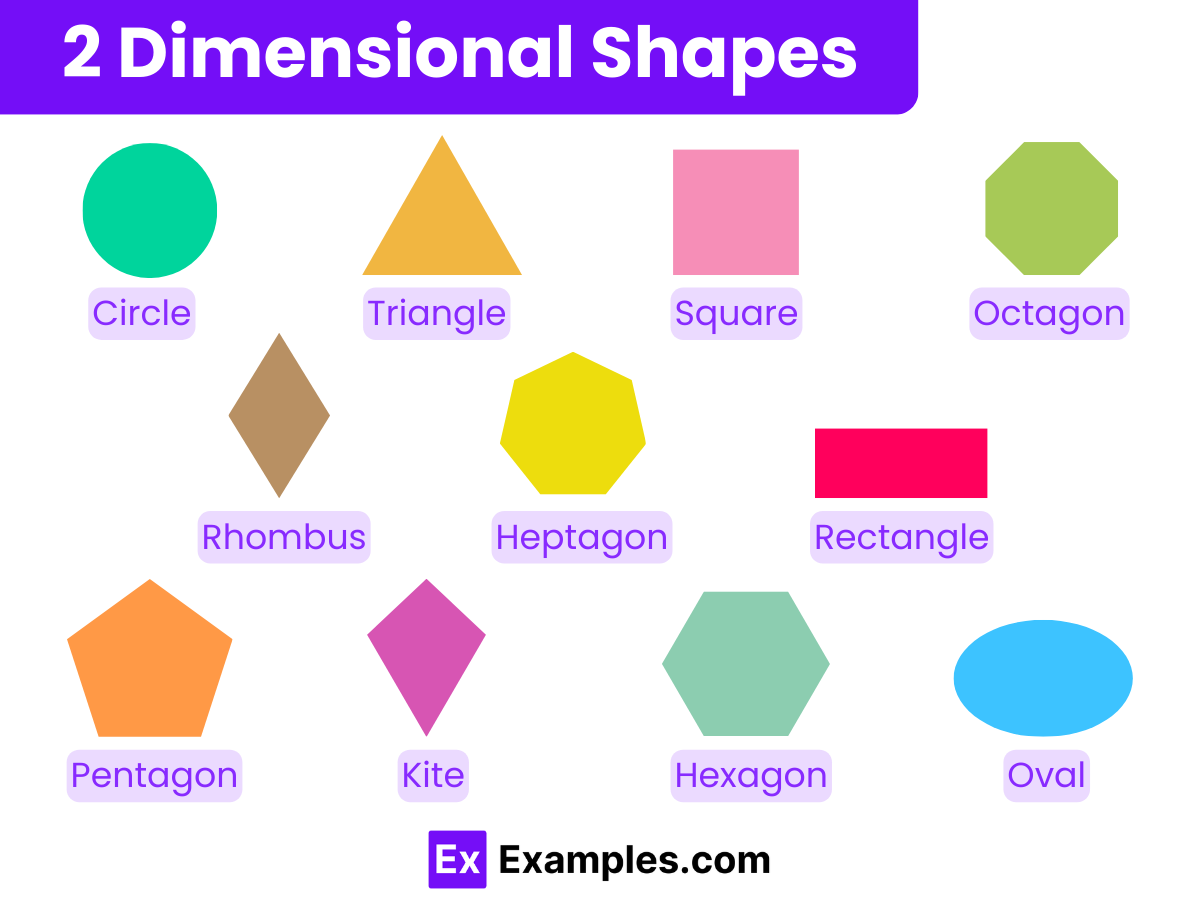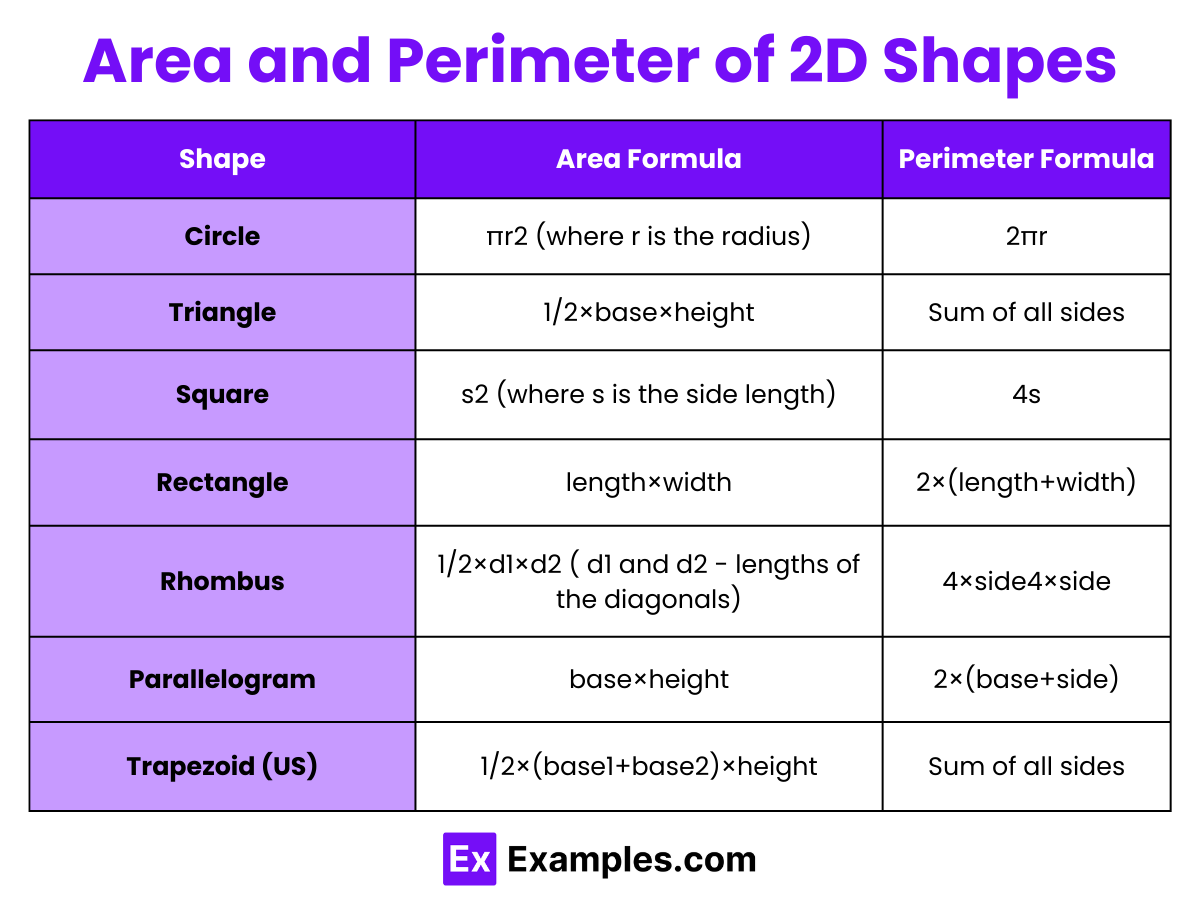What is the name of a 2D shape with four equal sides and four right angles?
Rectangle
Rhombus
Square
Trapezoid



Two-dimensional (2D) shapes can be categorized into regular and irregular shapes based on the equality of their sides and angles:
A circle is a perfectly round shape characterized by all points on the perimeter being equidistant from a single point in the center. Circles are unique among 2D shapes in having no straight edges or vertices. They are known for their infinite lines of symmetry.
A triangle is a polygon with three edges and three vertices. It’s the simplest polygon and can be classified based on side length (equilateral, isosceles, scalene) and angle (acute, obtuse, right). Each type of triangle has its own unique properties and uses.
A square is a regular quadrilateral with all four sides equal in length and all four angles at 90 degrees. It has four lines of symmetry and rotational symmetry of 90 degrees. Squares are often used in design and tiling due to their simplicity and symmetry.
A rectangle is a quadrilateral with opposite sides equal in length and all angles at 90 degrees. It has two lines of symmetry. Rectangles are commonly used in everyday life, from architectural designs to everyday objects.
A rhombus is a four-sided polygon with all sides of equal length, differing from the square in the angle of the corners, which are not 90 degrees.
A parallelogram is a quadrilateral with opposite sides that are parallel and equal in length. The opposite angles are also equal. Parallelograms do not usually have lines of symmetry but have rotational symmetry.
A trapezoid (US) or trapezium (UK) is a quadrilateral with at least one pair of parallel sides. In the US, a trapezoid has exactly one pair of parallel sides, while in the UK, it has at least one pair. This shape is commonly used in truss structures and bridges.
A pentagon is a five-sided polygon that can be regular (all sides and angles equal) or irregular. Regular pentagons have each internal angle measuring 108 degrees and exhibit rotational and reflective symmetry.
A hexagon is a six-sided polygon. In its regular form, each internal angle is 120 degrees. Regular hexagons are known for their efficiency in tiling and often appear in nature, such as in honeycomb structures.
An octagon is an eight-sided polygon that can also be regular or irregular. A regular octagon has each angle at 135 degrees. Stop signs are often shaped as regular octagons.
An ellipse, or an oval, is a curve on a plane that surrounds two focal points. The sum of the distances from any point on the ellipse to the two focal points is constant. Ellipses have two lines of symmetry, along the major and minor axes.

| Shape | Area Formula | Perimeter Formula |
|---|---|---|
| Circle | πr² (where r is the radius) | 2πr |
| Triangle | 1/2×base×height | Sum of all sides |
| Square | s² (where s is the side length) | 4s |
| Rectangle | length×width | 2× (length+width) |
| Rhombus | 1/2×d₁×d₂ (where d1 and d2 are the lengths of the diagonals) | 4×side4×side |
| Parallelogram | base×height | 2×(base+side) |
| Trapezoid (US)/Trapezium (UK) | 1/2×(base1+base2)×height | Sum of all sides |
| Aspect | 2D Shapes | 3D Shapes |
|---|---|---|
| Dimensions | Have two dimensions: length and width. | Have three dimensions: length, width, and height (or depth). |
| Appearance | Flat and can only be viewed from one perspective. | Solid and can be viewed from multiple perspectives. |
| Surface | Only one surface, which is the shape itself. | Multiple surfaces (faces). |
| Edges | Consist of straight or curved lines with no volume. | Have edges that are lines where two surfaces meet. |
| Vertices | Points where two edges meet. | Points where edges meet, often creating a corner. |
| Examples | Circle, triangle, square, rectangle. | Cube, sphere, cylinder, pyramid. |
| Measurement | Measured by area (e.g., square units). | Measured by volume (e.g., cubic units). |
| Common Uses | Used in drawings, designs, and flat surfaces. | Used in modeling real-world objects and structures. |
Regular 2D shapes have all sides and angles equal. Examples include equilateral triangles, squares, and regular pentagons.
A shape with 1,000,000,000,000,000 sides is called a “chiliagon,” generally used to describe any polygon with a very high number of sides.
The circle is often considered the most popular 2D shape due to its perfect symmetry and extensive use in various fields, including mathematics and design.
Text prompt
Add Tone
10 Examples of Public speaking
20 Examples of Gas lighting
What is the name of a 2D shape with four equal sides and four right angles?
Rectangle
Rhombus
Square
Trapezoid
How many sides does a pentagon have?
4
5
6
8
Which of the following shapes has exactly one pair of parallel sides?
Rectangle
Square
Trapezoid
Rhombus
What is the sum of the interior angles of a triangle?
90 degrees
180 degrees
270 degrees
360 degrees
What is the name of a 2D shape with six sides?
Pentagon
Hexagon
Heptagon
Octagon
How many diagonals does a rectangle have?
1
2
3
4
What is the name of a 2D shape with eight sides?
Hexagon
Heptagon
Octagon
Nonagon
Which of the following shapes is not a polygon?
Triangle
Circle
Pentagon
Hexagon
What is the sum of the interior angles of a quadrilateral?
180 degrees
270 degrees
360 degrees
450 degrees
Which shape has opposite sides that are parallel and equal in length, but does not necessarily have right angles?
Rectangle
Square
Rhombus
Trapezoid
Before you leave, take our quick quiz to enhance your learning!

